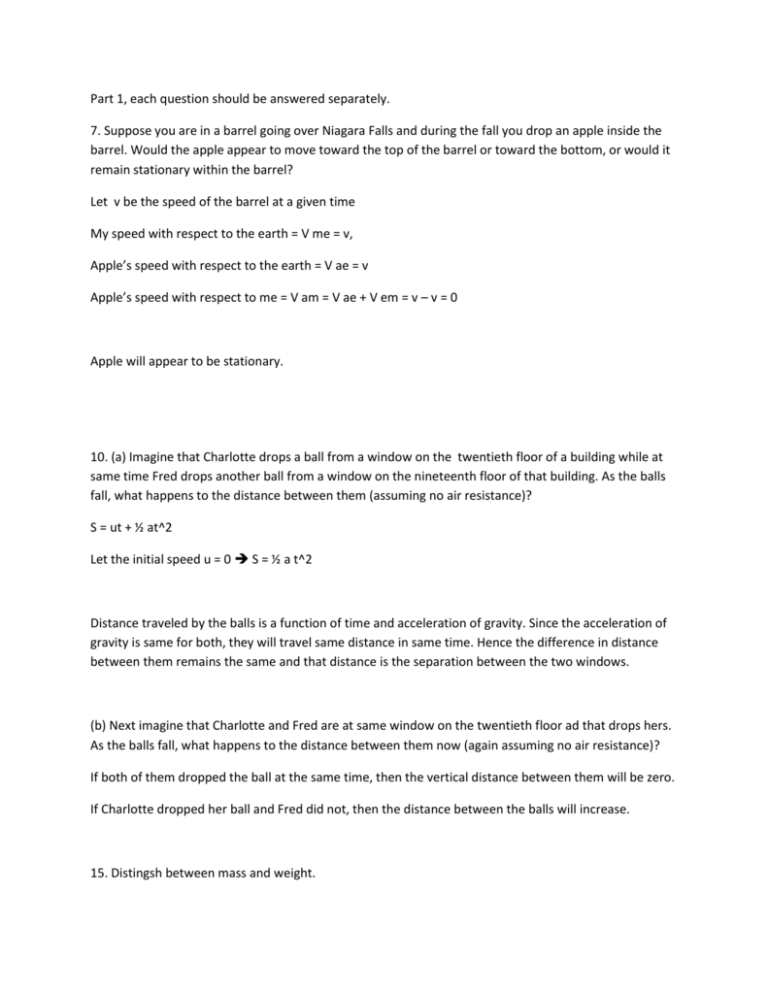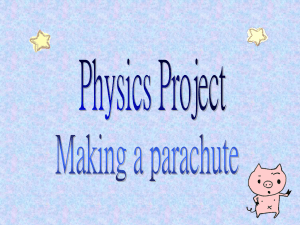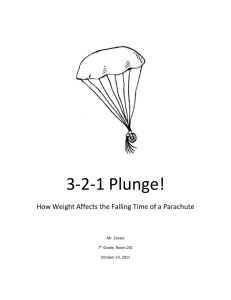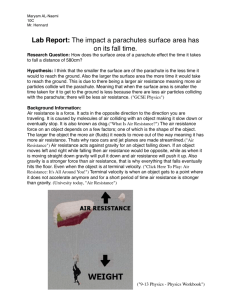Part 1, each question should be answered separately
advertisement

Part 1, each question should be answered separately. 7. Suppose you are in a barrel going over Niagara Falls and during the fall you drop an apple inside the barrel. Would the apple appear to move toward the top of the barrel or toward the bottom, or would it remain stationary within the barrel? Let v be the speed of the barrel at a given time My speed with respect to the earth = V me = v, Apple’s speed with respect to the earth = V ae = v Apple’s speed with respect to me = V am = V ae + V em = v – v = 0 Apple will appear to be stationary. 10. (a) Imagine that Charlotte drops a ball from a window on the twentieth floor of a building while at same time Fred drops another ball from a window on the nineteenth floor of that building. As the balls fall, what happens to the distance between them (assuming no air resistance)? S = ut + ½ at^2 Let the initial speed u = 0 S = ½ a t^2 Distance traveled by the balls is a function of time and acceleration of gravity. Since the acceleration of gravity is same for both, they will travel same distance in same time. Hence the difference in distance between them remains the same and that distance is the separation between the two windows. (b) Next imagine that Charlotte and Fred are at same window on the twentieth floor ad that drops hers. As the balls fall, what happens to the distance between them now (again assuming no air resistance)? If both of them dropped the ball at the same time, then the vertical distance between them will be zero. If Charlotte dropped her ball and Fred did not, then the distance between the balls will increase. 15. Distingsh between mass and weight. Mass is an intrinsic property of a body. It is same where ever the body may be. But weight of a body is a force, which a given mass feels due to the gravity at its place. It is measured in units of Newton 16. Albert is standing still on the ground. Does this mean that there is no gravitational force acting on him? If such a force is acting on him, why is he hot moving? When he is stationary, gravitational force ( = mg) still acts on him. This force is directed toward the center of the earth. Due to Newton’s third law, a reaction force acts upon him directly opposite to the direction of the gravitational force. Hence, the net force on him is zero. That is why a still person does not move due to the gravitational pull. 28. A hole is bored to the center of the earth and a stone is dropped into it. How do the mass and weight of the stone at the earth’s center compare with their value at the earth’s surface? Mass is an intrinsic property a body. Hence mass of the stone is same at the center of the earth as its value at the surface of the earth. But, weight is proportional to the acceleration of gravity. Acceleration of gravity is a function of the radius of the earth. In fact it is proportional to the earth’s radius. Hence as you move towards the center of the earth, weight drops linearly with radius reaching zero at the center. Part 2 Take a quarter and hold it so that it is parallel to the ground. Let the quarter drop and watch it fall. Then, take a penny and hold it parallel, and drop it from the same height and watch it fall. Share your findings including the differences in how each item falls (which is the fastest, which is the slowest, etc.). You do not need to include any numbers. Be sure to discuss what effect you think weight and shape have on how fast the items fall. If the air resistance is neglected, rate of fall of an object does not depend on the mass or the shape of the object. In this experiment, we can neglect the air resistance. We observed that both coins fell at the same rate. At any given instance their speeds were the same as well. Part 3 Describe the difference (in both what happens and why) between a person who jumps from an airplane with a parachute and one who jumps without a parachute. If a parachute is used, what would be the difference when the same size parachute is used on a person and then used on an elephant? Air resistance is given by F = k A V2 Where A is the area, V is the speed and k is a constant. When the person has reached his terminal speed Vt, net force on him = 0. Hence, Upward air resistance = weight k A Vt2 = mg Vt = sqrt(mg/kA) ------------ (1) This expression will help us to answer the following two questions. Difference (in both what happens and why) between a person who jumps from an airplane with a parachute and one who jumps without a parachute An open parachute provides more area. This will result in a smaller terminal velocity according to eq. (1). A person without a parachute will reach a larger terminal speed due to his smaller body area. Difference between an elephant and a person on identical parachutes. Elephant’s mass is much larger than a human’s mass. Terminal velocity is proportional to the mass according to eq.(1). So elephant’s terminal speed will be larger than that of a person.











